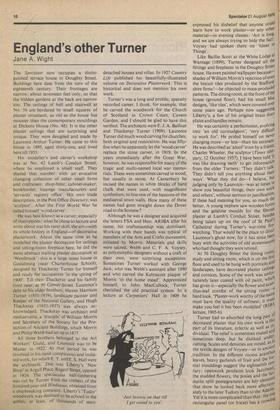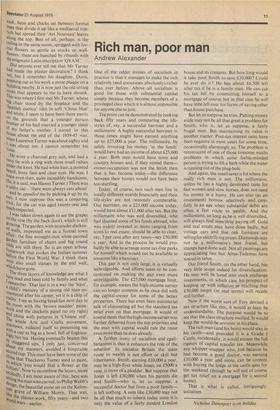England's other Turner
Jane A. Wight
The Spectator now occupies a distinguished terrace house in Doughty Street. Buildings here date from the turn of the eighteenth century. Their frontages are narrow, about seventeen feet only, so that the hidden gardens at the back are narrow too. The ceilings of hall and stairwell at No. 56 are bordered by small squares of plaster ornament, as old as the house but mousier than the contemporary mouldings at Dickens House (No. 48). It is the other plaster ceilings that are surprising and unique. They were designed and made by Laurence Arthur Turner. He came to this house in 1895, aged thirty-one, and lived here till 1953.
His modeller's and carver's workshop was at No. 42 Lamb's Conduit Street, where he employed a small staff. They shared that number with an evocative changing collection of other small firms and craftsmen : shop-fitter, cabinet-maker, bookbinder, lozenge manufacturers and 'servants' registry office'. His own trade description, in the Post Office Directory, was 'sculptor'. After the First World War he called himself 'wood carver'.
He was best known as a carver, especially of inscriptions; what he chose to lecture and write about was his rarer skill, the art—with its whole history in England—of decorative plasterwork. About the same time as he modelled the plaster decoration for ceilings and sitting-room fireplace here, he did the more abstract trailing plaster decoration at 'Westbrook' : this is a large stone house in Godalming ( near Charterhouse School), designed by Thackeray Turner for himself and ready for occupation 'in the spring of 1900'. Till then Thackeray and his family lived near, at 90 Gower Street. Laurence's debt to his older brothers, Hawes Harrison Turner (1851-1939), landscape painter and Keeper of the National Gallery, and Hugh Thackeray (1853-1937) was always acknowledged. Thackeray was architect and mediaevalist, a 'disciple' of William Morris and Secretary of the Society for the Protection of Ancient Buildings, which Morris and Philip Webb had set up in 1877.
All three brothers belonged to the Art Workers' Guild, and Laurence was to be Master in 1922. At that period he was involved in his most conspicuous and imitated work, for which E. T. and E. S. Hall were the architects. This was Liberty's 'New Shop' in Argyll Place, Regent Street, opened in 1924. The spectacular half-timbering was cut by Turner from the timbers of the hundred-year-old Hindustan, obtained from a shipbreaking company. Liberty's 'Tudor' woodwork was destined to be echoed in the gables, at least, of thousands of semi
detached houses and villas. In 1927 Country Life published his beautifully-illustrated volume on Decorative Plasterwork. This is historical and does not mention his own work.
Turner's was a long and prolific, sparsely recorded career. I think, for example, that he carved the woodwork for the Church of Scotland in Crown Court, Covent Garden, and I should be glad to have this verified. The architects were E. J. A. Balfour and Thackeray Turner (1909). Laurence Turner did much wood carving for churches, both or iginal and restoration. He was fiftyfive when he apparently let the 'wood carver' replace the stone carver, in 1919. In the years immediately after the Gteat War, however, he was responsible for many of the tragic and multi-named local war memorials. These were sometimes carved in wood, but usually in stone. At Canterbury he incised the names in white blocks of hard chalk that were used, with magnificent symbolism, to line one of the bastions ot the mediaeval town walls. How many of these names had gone straight down the Dover road to the Somme ?
Although he was a designer and acquired the letters FSA and Hon. ARIBA after his name, his craftsmanship was dominant. Working with their hands was typical of members of the Arts and Crafts movement, initiated by Morris. Materials and skills were sacred. Webb and C. F. A. Voysey, as polymorphic designers without a craft of their own, were surprising exceptions. Sometimes Turner worked with George Jack, who was Webb's assistant after 1880 and who carved the Kelmscott plaque of Morris 'in the home mead'. Apprenticed himself, to John MacCullock, Turner cherished the old practical system. In a lecture at Carpenters' Hall in 1909 he
Spectator 21 August 1976 expressed his disbelief that anyone could learn how to work plaster—or any other material—in evening classes: 'Art is long, and we are always trying to hide the fact . Voysey had spoken there on 'Ideas ill Things'. Like Baillie Scott at the White Lodge at Wantage (1899), Turner designed all the fittings and fireplaces in the Doughty Street house. He even painted wallpaper because shades of William Morris's rejection of even the biscuit tiles produced by the Staffordshire firms !—he objected to mass-produced patterns. The dining room, at the front of the house (ground floor), had his small blue designs, 'like tiles', which were covered over some years ago. Perhaps now suggesting Liberty's, a few of his original brass door plates and handles remain.
He was certainly a perfectionist, evolving
into 'an old curmudgeon', 'very difficult to work for'. He prided himself on never charging more—or less—than his estimate. He was described as 'aloof ' even by a friend, Charles Wheeler, the sculptor (Times obituary, 12 October 1957). I have been told '1t was like drawing teeth' to get information from the older Turners: 'They didn't talk. They didn't tell you anything about their ways'. What they did do—I believe, but judging only by Laurence—was at times to show you beautiful things, their own work and others', without sermon or justification. If these had meaning for you, so much the better. A young nephew saw wooden forms and the gelatine moulds for the fibrous plaster at Lamb's Conduit Street, besides being taken up on the roof of St Paul's Cathedral during Turner's war-time fire' watching. That would be the place to direct Laurence's ghost now, for it has since been busy with the activities of old stonemasons who had thought they were retired.
At 56 Doughty Street the dining roorn,
study and sitting room, which is on the first, floor and used to be hung with portraits an' landscapes, have decorated plaster ceilings and cornices. Some of the work was unf01: tunately later coated with oil paint, whicn has given it—especially the flower and acanthus-leaf cornke of the sitting room hard look. 'Plaster-work worthy of the narne must have the quality of softness; it Mos.: make you feel it has been modelled' (RIB'' lecture, 1905-6).
of
Turner had so absorbed the long Pas-t .„ decorated plaster that his own work is li" part of its literature, eclectic as well as in; dividual. The relief is sometimes muted an° sometimes deep, but he disliked unde,r'' cutting. Scales and densities are mixed, as in the textile designs of Voysey—or in ancients tradition. In the different rooms acantilLI leaves, heavy garlands of fruit and the formal mouldings suggest the eighteenth cen: tury; openwork pendants look Jacobeanv, the studded flowers, the posies and the fa; ourite split pomegranates are key eternal" that show he looked back more affections" ately to the later Tudors than to the Adair _ Yet it is more complicated than that : the rectangular panel (or frieze) has a crooning. cock, hens and chicks set between formal trees that divide it up like a mediaeval triptYch but spread their 'Art Nouveau' leaves along the top. Best of all, perhaps, is the ceiling in the same room, sprigged with formal flowers as gentle as stocks or wallflowers: these are bunched by ribands with theenigmatic Latin inscription 'QVAM' Did anyone ever tell me that Mr Turner had made the plaster decoration? I think not, but I remember his daughter, Doris„ Pointing out as his work a stone plaqUe on a building nearby. It is now just the old sitting Top that appears to me to have shrunk. 'his was where I first met Mr Turner, whose big chair stood by the fireplace and the Spanish cuenca' tiles in soft 'China blue' and white. I seem to have been there partly ori the grounds that a younger parson brother of his had married a younger sister °Lf my father's, mother. I stayed in this 'louse about the end of the 1939-45 war, wi hen Laurence Turner was about eighty and Was about ten. I cannot remember his voice.
He'wore a charcoal grey suit, and had a navy tie with a ring with three small rubies under the knot. He had white hair, a pointed beard, bony face and clear eyes. He was, I ew even then, quite incredibly handsome. ‘40, it is said, was Hawes Turner.) There was a tabby cat—'there were always cats about' --and he appalled me by picking it up by its ears. I now suppose this was a conjuring trick, for the cat was aged twenty-one and thuch respected. I was taken down again to see the grapes On the vine (by the back door), which is still !,t'awing. The garden, with itssmoke-darken`4 walls, impressed me as a formal town affair: the fine wrought-iron white-painted garden furniture of chairs and big round fable are still there. So is an open arbour Ltarnework that evokes the Indian summer uefore the First World War. I think there were also small statues by the end wall, Allich have gone. h The three layers of knowledge are what 1 I "a read and been told by family and what ' remember. That last is in a way the 'least', child's memory of a strong old man enthIntered after his career, yet it is a chip of trity. I see us having breakfast next day in „ e room with the 'brown madder' paint:veld( and the chickens panel (to my right) gild china with patterns in 'Chinese red'. , he whole Arts and Crafts movement, awo.known, reduced itself to presenting me ith a cup as big as a bowl, full of frightentr,'elY hot tea. Having eventually beaten this staggered sips, I only just, concerned 0 u t my manners, avoided a hospitable 7fi,.ond cup. This must have been some of the ilna that Thackeray Turner used to paint, which 'you would find a flower at the eu)r°rti% Now to recombine the layers, more stedly, I am most aware of this: here was d Lting the man who carved, to Philip Webb's ten, the beautiful stone set on the Kelms vtt grave of William Morris. That was, w" the plaster-work, fifty years—and two °rid wars—earlier.



































 Previous page
Previous page